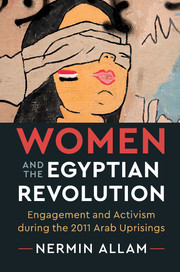Book contents
- Women and the Egyptian Revolution
- Women and the Egyptian Revolution
- Copyright page
- Dedication
- Contents
- Acknowledgments
- A Note on Transliteration and Translation
- Introduction: A Dramaturgy of Women, Egypt, and the 2011 Egyptian Uprising
- 1 Women and Egypt’s National Struggles
- 2 Activism and Exception: Media and the Framing of Women’s Engagement in the 2011 Egyptian Uprising*
- 3 Trenching Dissent: Women’s Collective Action Frame in the Uprising*
- 4 An Epicenter of Solidarity: Women’s Recollections of the 18-Day Uprising*
- 5 “Intu Bitoʿ Sūzān” (You Are Suzanne’s Clique): Gender and Political Opportunities in the 2011 Uprising*
- 6 What Holds Next?: The Politics of Hope and Disappointment*
- Conclusion
- Bibliography
- Index
- References
Bibliography
Published online by Cambridge University Press: 28 December 2017
- Women and the Egyptian Revolution
- Women and the Egyptian Revolution
- Copyright page
- Dedication
- Contents
- Acknowledgments
- A Note on Transliteration and Translation
- Introduction: A Dramaturgy of Women, Egypt, and the 2011 Egyptian Uprising
- 1 Women and Egypt’s National Struggles
- 2 Activism and Exception: Media and the Framing of Women’s Engagement in the 2011 Egyptian Uprising*
- 3 Trenching Dissent: Women’s Collective Action Frame in the Uprising*
- 4 An Epicenter of Solidarity: Women’s Recollections of the 18-Day Uprising*
- 5 “Intu Bitoʿ Sūzān” (You Are Suzanne’s Clique): Gender and Political Opportunities in the 2011 Uprising*
- 6 What Holds Next?: The Politics of Hope and Disappointment*
- Conclusion
- Bibliography
- Index
- References
- Type
- Chapter
- Information
- Women and the Egyptian RevolutionEngagement and Activism during the 2011 Arab Uprisings, pp. 167 - 212Publisher: Cambridge University PressPrint publication year: 2017



